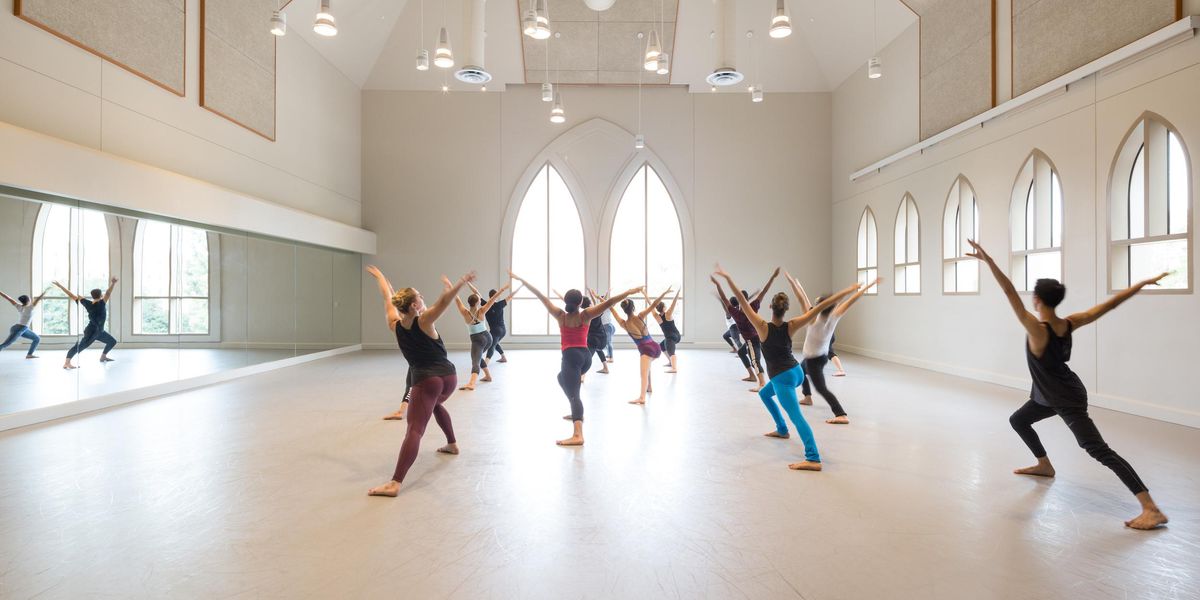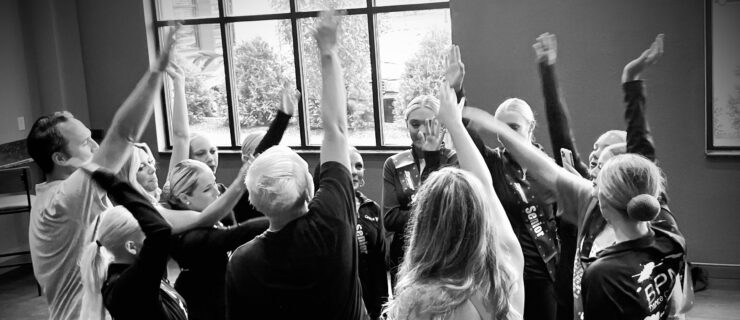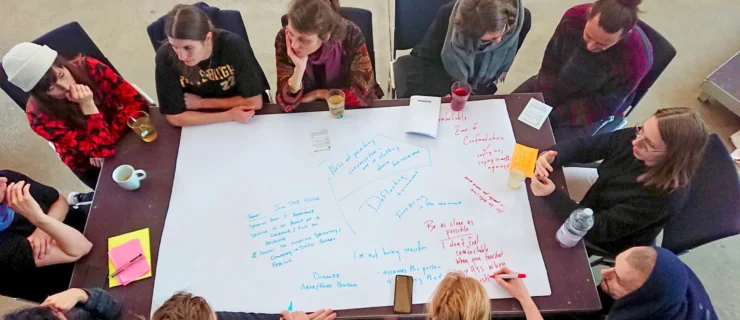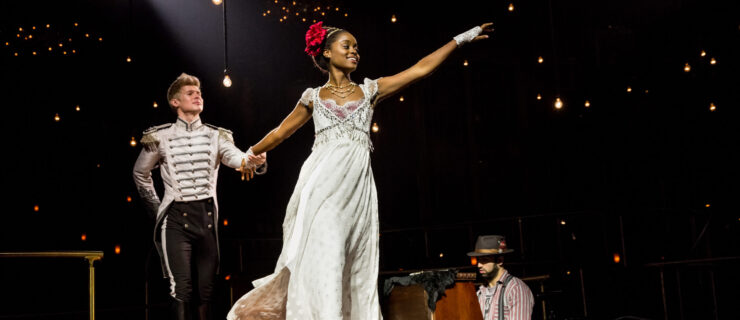Plugged In
Pina, Merce Cunningham Dance Company’s final performances, and Dance Crazy in Hollywood on DVD; Works & Process livestream events; DanceMotion USA blog; Tango Nuevo book
Pina Bausch’s
Vollmond, Photo: Courtesy Criterion
DVDs
Pina
The Criterion Collection. 103 minutes. $29.95. (Blu-ray 3-D/Blu-ray edition $49.95.)
The documentary Pina, a love letter from film director Wim Wenders and the dancers of Tanztheater Wuppertal to their late director, is now available on DVD. In addition to the dazzling film (see “Plugged In,” Dec. 2011), a second disc of bonus features sheds light on the filming process—and the company’s inner workings. In “The Making of Pina,” Wenders explains that the film was entirely dependent on the availability of 3-D, and how it was reborn after Bausch’s sudden death. We briefly see the company in class and rehearsal—Sacre in practice clothes is a revelation—and hear the mélange of languages in which the dancers and artistic staff communicate.
Some of Pina’s most affecting moments come from the excerpted solos and duets, shot in and around the picturesque city of Wuppertal. It’s no wonder: Wenders explains that he echoed Bausch’s own creative process of asking the dancers questions and having them respond not with words, but movement. He requested, though, that they choose phrases that Bausch “had her eyes on, that you had worked on together,” as he says in the film.
Gems found in the 14 deleted scenes include Fernando Suels Mendoza’s undulating solo from Bamboo Blues and Dominique Mercy’s poignant performance from Iphigenia in Tauris, the first solo he performed for Bausch in 1973. This Criterion Collection release deepens the experience of an already brilliant film, in which the humanity of Bausch’s dances can be kept forever. —Kina Poon
…………………………………………………………………………………………………………………………….
Merce Cunningham Dance Company: Park Avenue Armory Event
ARTPIX. 279 minutes (3 discs). $60.00.
Whether or not you were at the Park Avenue Armory on the eve of 2012, when the Merce Cunningham Dance Company gave its final performances—the glorious home stretch of its two-year, international Legacy Tour—this beautifully shot and edited collection offers a fresh, transporting perspective on what happened there.
As an audience member at the event—a collage of Cunningham excerpts performed simultaneously on three stages, planted in the middle of the Armory’s imposing, 55,000-square-foot Drill Hall—you had the freedom to wander throughout the space and seek out various vantage points, or simply to stay put and let your eye wander between the dancing on each stage. On Disc 1 of this three-disc set, the camera re-creates that exhilarating sense of multiplicity, swooping between the activity on each platform, while getting closer to the tremendously complicated choreography (and the intensely focused musicians) than any spectator could have. So it is that we see the trembling tendons of Andrea Weber’s feet, supporting the equanimity of everything above them in her viscous solo from Way Station (2001). Then suddenly, we remember the vast, intricately teeming space around her, as the camera cuts to a wide shot encompassing the other two stages, a skittering quintet evolving on one as a sequence of leaps springs up on the other, all under the hovering presence of Daniel Arsham’s molecular, cumulous sculptures.
Disc 1, true to the live viewing experience, doesn’t capture everything, but Disc 2 compensates with uncut recordings of the performances on each stage. Disc 3 includes excerpts from all of the dances performed on the Legacy Tour, including archival gems from early works like Antic Meet and RainForest, featuring Merce, the dancer, himself. —Siobhan Burke
(From left: Jamie Scott, Brandon Collwes, and Marcie Munnerlyn. Photo: Stephanie Berger, Courtesy ARTPIX)
…………………………………………………………………………………………………………………………….
Dance Crazy in Hollywood
Arthaus Musik. 57 minutes. $24.99.
The movie musicals of the mid-1900s are some of dance’s true gems. But many dancers don’t know that the choreographer behind much of the stylized movement was the twinkly, elfin-faced Hermes Pan. The Tennessee-born strutter had no formal dance training other than impromptu tap lessons with neighborhood chums. Nevertheless, his unique, fleet-footed choreography and light-hearted approach to dance earned him a priority spot in the Hollywood scene: Not only was he a constant collaborator of Fred Astaire, but he was also a favorite coach and choreographer for Cyd Charisse, Rita Hayworth, and Katharine Hepburn.
Now, veterans and young students alike hoping to learn more about the Golden Era style can get inspired by Art-haus Musik’s documentary, Dance Crazy in Hollywood. Focusing on Pan’s time on the MGM lots, the documentary is filled with precious nuggets of movie clips, like Charisse’s raw mountain dance in Sombrero. Together, the slew of clips demonstrates Pan’s prominence behind the silver screen.
Though the film begins with a French-accented narrator, eventually Pan himself takes over, sharing stories and conversations with stars, as well as his notions about choreography: His ideas about creating without a heavy hand and interacting with the stars are amusing, clear, and informative for budding dancemakers.
Though viewers would be better served by titles that accompany the clips instead of the listing at the end of the film, the whimsical documentary is a good starting point. (For a great primer on the Golden Era, follow up on all the movies mentioned in the film.) Dance Crazy is for dancers who are looking to brush up on an influential time and choreographer. —Lauren Kay
Livestream
The Guggenheim Museum’s Works & Process series fields three high-profile programs this month. Wendy Whelan, New York City Ballet’s mercurial goddess, performs excerpts from her upcoming independent evening, “Restless Creature,” in which she teams up with young contemporary choreographers for a group of duets. In concert with Season of Cambodia (see “Dance Matters”), Amrita Performing Arts presents dances by Khmer-French choreographer Emmanuèle Phuon. And American Ballet Theatre displays its dancers’ versatility in a program that anticipates its season at the Metropolitan Opera House next month.
See www.guggenheim.org and www.ustream.tv/worksandprocess for dates and times. —K. P.
(Left: Wendy Whelan, Photo: Nisian Hughes, Courtesy Guggenheim)
Websites
Journey to Argentina and Algeria, Belarus and Bangladesh, with DanceMotion USA, as four dance companies embark on month-long goodwill tours, at www.dancemotionusa.tumblr.com. Dancers share photos, videos, and short posts that provide a snapshot of each company’s experience online. This year’s cultural ambassadors join the likes of Trey McIntyre Project and ODC/Dance. See NYC’s Doug Varone and Dancers’ dispatches from South America, Hubbard Street’s adventures in northern Africa, Spectrum Dance Theater’s discoveries in South Asia, and the hip-hop stylings of Philadelphia’s Illstyle & Peace Productions in Russia and neighboring countries. The site catalogues the performances, workshops, and informal exchanges fostered by bringing American dance abroad. —K. P.
Books
Tango Nuevo
By Carolyn Merritt. University Press of Florida. 2012. 272 pages. $24.95.
Not only is Carolyn Merritt a dynamic hybrid—American-born anthropologist, writer, and dancer—but so is her fascinating Tango Nuevo, part memoir, part academic study of the culture of Argentina’s signature social dance.
Merritt draws us into her adventures in Buenos Aires, where she learned the moves and absorbed the conventions of the milongas (traditional) and prácticas (less formal venues) and interviewed numerous tango professionals. Here each dancer may choose to maintain rigid gender norms or negotiate a fluid yin/yang of expression. There is even a flourishing “queer tango” scene.
In her attempt to pin down the emerging term tango nuevo—innovative, physically demanding, sometimes edgy approaches that separate “the kids” from the old guard—Merritt discovered that many tangueros reject this marketing label. From its earliest manifestations, they argue, tango has been the very spirit of evolution.
Merritt discusses the rise and fall and triumphant rebound of this seductive dance, from its origins in the slums and bordellos of multi-ethnic Buenos Aires to its decline under the dictator Juan Perón. At times, her analytical discourse can be dense. Readers may flee to YouTube for a more immediate, visual connection to the matter at hand. Even so, we owe thanks to Merritt for sparking curiosity about the world of tango that may yet become a love affair. —Eva Yaa Asantewaa




